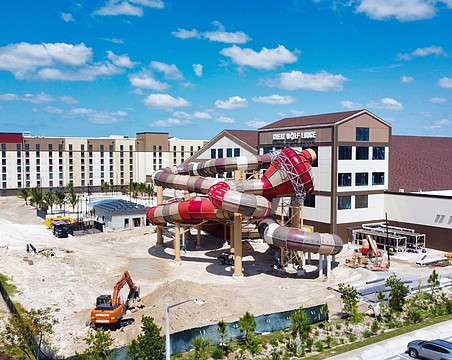For years, flood insurance was a sleepy area of the insurance industry. It was relatively affordable and most parts of Florida weren't affected anyhow.
But that quickly changed when the government decided to redraw antiquated maps, turning wide swaths of Southwest Florida land into flood zones and forcing property owners to consider insurance.
Josh Evans saw it coming.
In 2010, the WilsonMiller alumnus started J.R. Evans Engineering in Estero, specializing in helping landowners appeal to have their properties removed from the riskiest flood zones.
That effort has taken on special urgency now that the federal government is scheming to raise flood-insurance rates. It's big news because some property owners are reporting huge spikes in premiums.
So far, Evans estimates he's helped landowners save $2 million in annual flood-insurance premiums. His 15-person firm is now working on projects that will save landowners another $1 million in premiums every year.
Even more critical than insurance rates, the law limits whether property owners can rebuild if a building is destroyed in a high-risk flood zone. That fact can easily deflate property values and make it virtually impossible to sell because of the inability to rebuild in the future.
In addition to the flood-insurance work, Evans says he's seeing a resurgence of residential land-development projects that include water-related engineering challenges. He says there's at least three years' worth of such work in the pipeline, barring unforeseen disasters. “It's insane right now,” Evans says. “There's a massive shortage of new homes.”
Evans declines to cite financial performance for his firm, but he says it's growing fast. “We've doubled in size every six months for the last two years,” he says.
Insurance spikes
For commercial buildings and condo communities, where they fall in the redrawn flood maps can make a huge difference in insurance premiums.
For example, Bonita Vandall, community association manager with Resort Management in Naples, says one community she oversees with 19 buildings in the flood zone could face flood insurance annual premiums of $55,000 a year. If J.R. Evans' request for a map change is approved, some of those buildings will be removed from the riskiest flood zones and premiums will total $21,000 a year.
In another case, David Sumner, executive vice president with Insurance and Risk Management Services in Naples, says he's working with J.R. Evans to remove two buildings from a high-risk zone to save the owners $10,000 in premiums. Just 10 feet of the property is in the high-risk zone, so both buildings were lumped into that flood zone, he says. “You really need the expertise of an engineer,” Sumner says.
Evans says it's important not to file frivolous requests for a map change from the Federal Emergency Management Agency, the government agency overseeing the flood-map program. As a result, none of Evans' requests has been turned down. “FEMA appreciates the input to their model,” he says, noting that it provides more detail for their maps. “They know our firm.”
“It's a process and you've got to know who to talk to,” says Sumner, who has referred clients to Evans. “That's a key component.”
Of course, the science that backs up a request for a map change is a report several inches thick, often 300 to 400 pages of conclusions and supporting data on a variety of factors from ocean tides to the mitigation of dunes, vegetation and other barriers. For a condo building on the beach, it costs between $40,000 to $80,000 to seek a map change, Evans says.
Because of the expense of such an endeavor, Evans' work is limited to commercial buildings and condo towers, especially in built-up areas such as Marco Island in Southwest Florida and Sunny Isles on the east coast. Evans lays the groundwork by doing extensive research on those areas before he starts canvassing building owners. Still, Evans has helped remove entire residential communities such as 51 multifamily residential buildings inside Rapallo in the Estero area of south Lee County.
Initially, Evans acknowledges that building owners are surprised by the high cost of the engineering study that backs up a map-change request. But once owners realized the savings in premiums, the cost isn't as much of a barrier. “They tell their neighbors,” he says. “Once we do one or two, it's viral.”
Although most of Evans' work is focused on South Florida, he's expanded to Texas, where his firm is evaluating a map-change request for a building in Galveston. Evans acknowledges that going outside of Florida may prove challenging. “Texans do work with Texans,” he says.
Growing the firm
Evans says he's been able to grow his engineering firm by reinvesting the profits. He's not keen on building his firm too quickly for fear of having to lay off employees if there's another economic downturn. “I see the opportunities to be exponential,” he says, but he adds: “We're growing cautiously.”
For one thing, the flood-insurance rate increases may not be as extreme if Congress decides to continue to subsidize coastal property owners. Evans claims no special insights into politics. “I don't know what's going to happen,” he says. “What we've been doing is relatively cutting edge.”
“Less than 5% of the policies written are really being significantly impacted with the rate increases,” says Sumner. Older commercial buildings and non-primary homes built in flood zones are most vulnerable to rate increases, he says.
News of some extreme rate increases and political uncertainty are fueling concerns, however. “There's a lot of hype out there with some of the changes and it's definitely what people are focusing on now,” Sumner says.
Evans says his firm has a long list of projects that include thousands of parcels, including about 50 large-scale ones. “We have a decent amount of momentum,” he says.
The flood work represents about 50% of the revenues of J.R. Evans and the other 50% is land-development work. “Our biggest client is Pulte Homes,” he says, noting that he's working on three Pulte projects that encompass 600 to 800 acres each in Southwest Florida.
To further diversify, Evans has launched another firm called KMF Environmental Consulting to evaluate and help companies prevent contamination from fuel tanks. He's also starting another firm to help clients with clean-water extraction and use. “I funded them through the profits of the company,” he says.
In the end, J.R. Evans is more limited by the ability to recruit the top people. “It's more expertise-intensive than capital,” Evans says.






